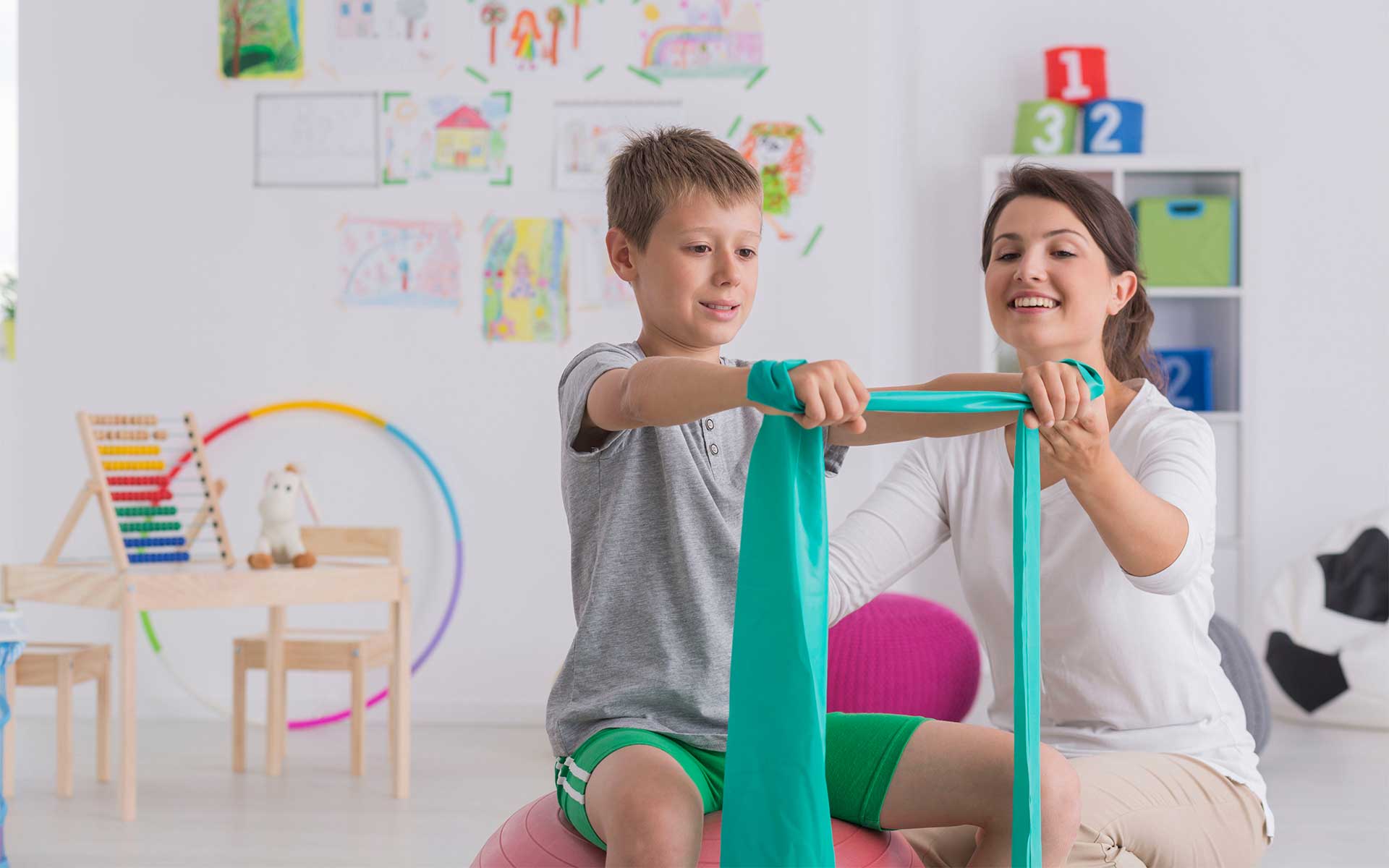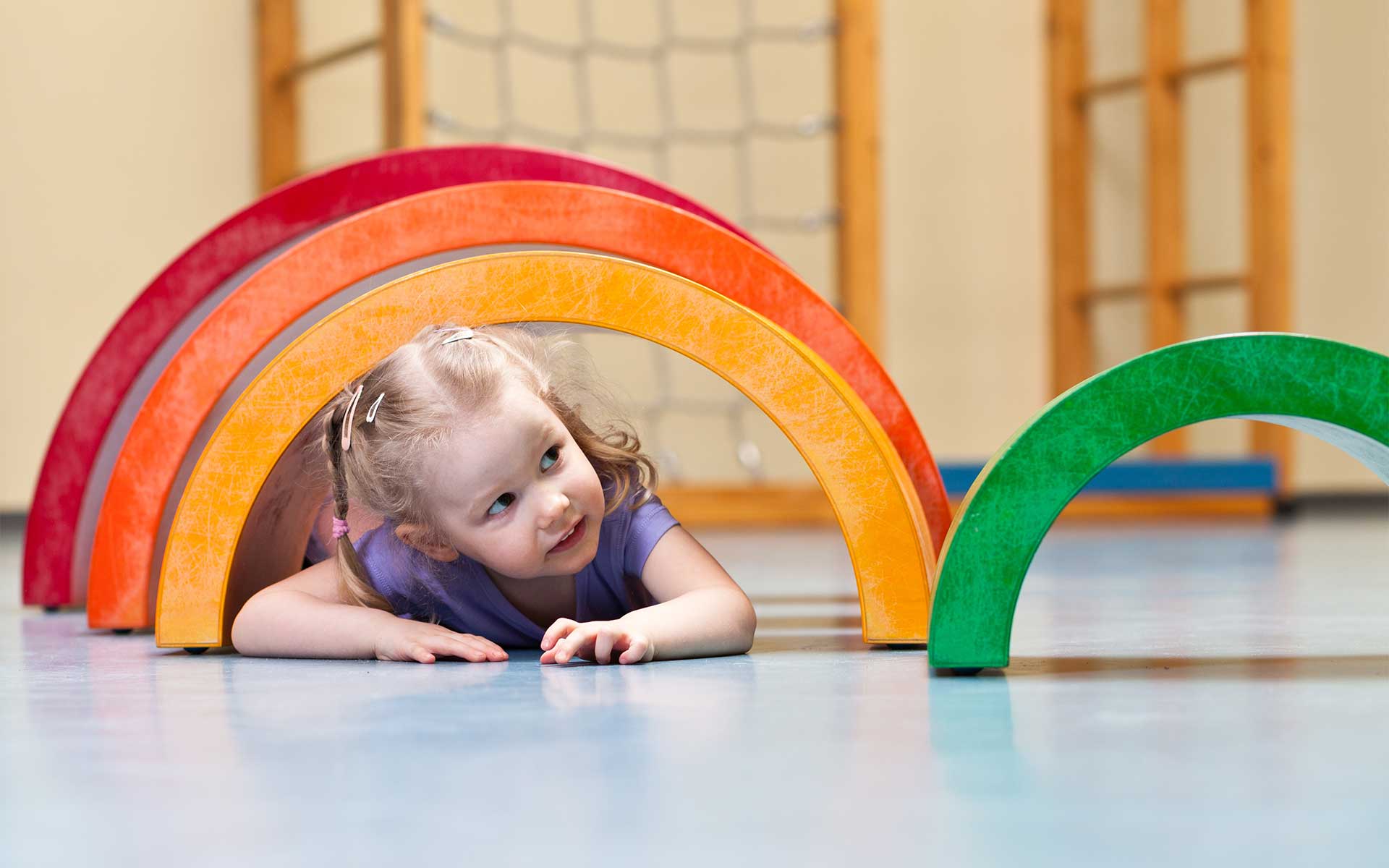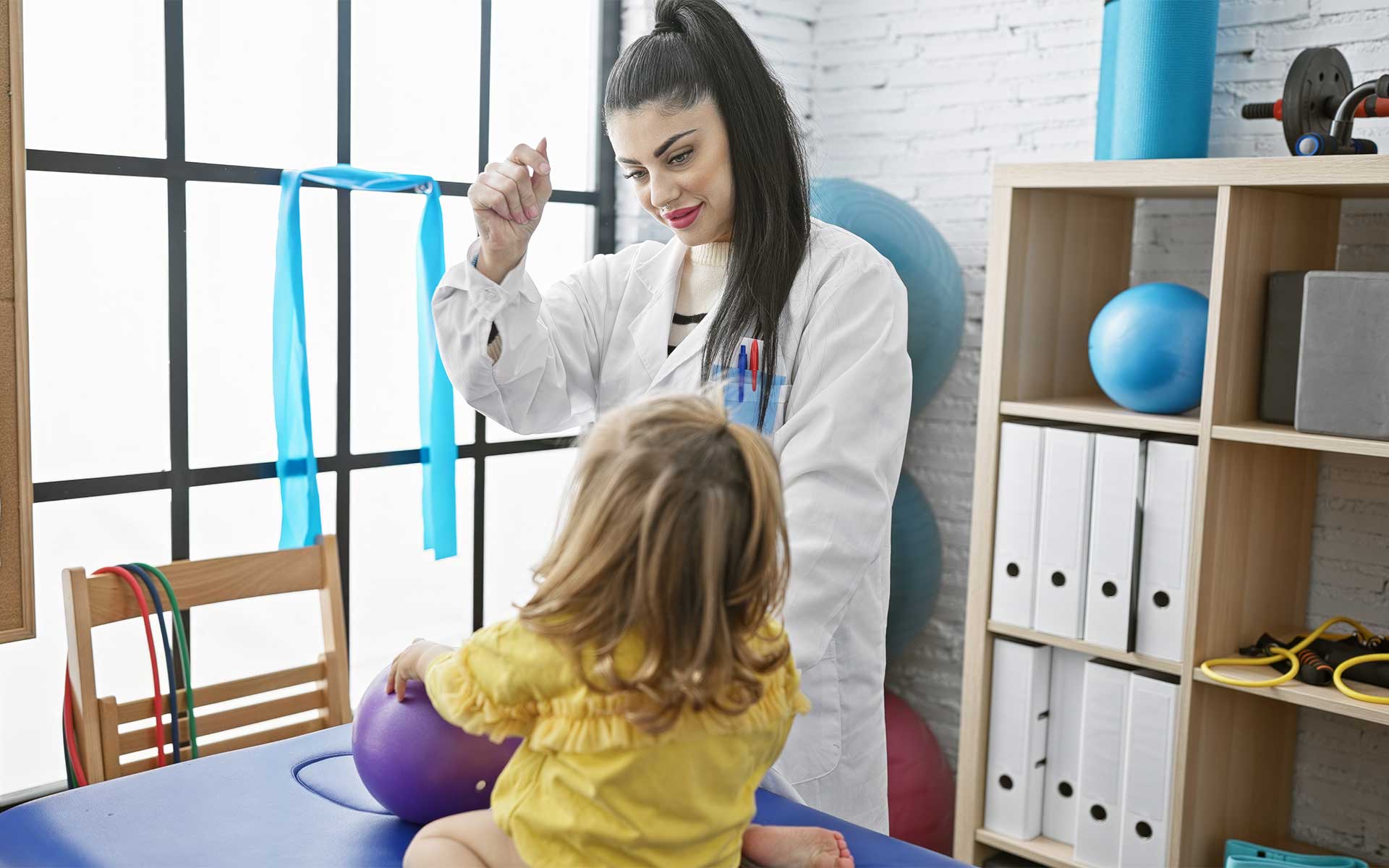
Pediatric physical therapy focuses on assessing, diagnosing, and treating children experiencing movement difficulties, developmental delays, disabilities, or injuries. In practice, a licensed pediatric physical therapist works with young patients to improve their functional abilities, mobility, independence, and quality of life during pediatric physical therapy.
Whether physical therapy is for improving mobility, overcoming motor skill challenges, or speeding the healing process after surgery, exercises for pediatric physical therapy can benefit children from infancy to adolescence.
Often, therapists incorporate pediatric physical therapy activity ideas that are both beneficial and fun. Today, we’re exploring 10+ fun pediatric physical therapy exercises that address strengthening core stability, motor skill development, and sensory processing. We will briefly describe each exercise/activity, including the areas they address.
How Does PT Help Children?
A child may require physical therapy services for many reasons, such as improving weak muscles or tight tendons or helping children overcome the challenges associated with developmental or neurological disorders.
Pediatric physical therapy activities help children with conditions that make normal movement or development difficult, such as developmental delays, congenital conditions, injuries, or neurological disorders. Following are some examples of conditions or diagnoses that fall within one or more of these categories:
- Developmental Delays
- Cerebral Palsy
- Autism
- Toe walking
- Spina bifida
- Muscular Dystrophy
- Hypotonia
- Down Syndrome
- Torticollis
- Post-Surgery recovery
- Recovery after sports or play-related injuries
What Types of Exercises Do Pediatric Physical Therapy Sessions Include?

Each child’s treatment plan will differ based on their condition, development, and age. Like adult PT sessions, physical therapy pediatric exercises serve a purpose. Once a pediatric physical therapist evaluates the child, they create a treatment plan or pediatric physical therapy home exercise program to address unique development or mobility needs.
Treatment for children often includes physical therapy with pediatric exercises in the form of fun and engaging games and activities. The pediatric physical therapy activities introduced next will sound more like play than therapy. However, keeping these exercises fun encourages participation among younger PT patients.
3 Types Of Pediatric Physical Therapy Exercises
These pediatric physical therapy exercises can help improve children and adolescents’ functional ability, strength, range of motion, or gross/fine motor skills. Caregivers or therapists can perform them almost anywhere. We have organized these physical therapy activities for pediatrics into core strengthening, motor skill-boosting, and sensory processing.
Core Strengthening Exercises
Core strength is crucial for maintaining stability and balance during functional mobility tasks such as sitting, standing, transitioning between positions, and performing activities of daily living. Core strengthening exercises are valuable components of pediatric physical therapy intervention activities and help support children with special needs, manage orthopedic conditions, or support functional mobility.
The following fun pediatric physical therapy balance exercises can help promote and support optimal physical development, functional abilities, and participation in daily activities for children of all ages and abilities.
Animal Walk
The animal walk is fun pediatric physical therapy active kids can enjoy in any setting. All you need is some tape and space. Begin by placing two pieces of tape about 10 to 20 feet apart. Next, instruct the child to begin at one piece of tape and walk like an animal to the other piece of tape. They will use critical thinking to imagine how animals walk and their physical ability to mimic the motions while moving between the tape pieces.
Tightrope Walk
The tightrope walk is one of the most accessible pediatric physical therapy balance activities. All it requires is a length of tape and space for walking. Begin by stretching the tape out in a straight line. Next, have the child walk the line as if on a tightrope. Walking in a straight line like this requires concentration and balance, engaging critical core muscles for balance and coordination.
Stuffed Animal Elevator Rise
This game is an excellent addition to any pediatric physical therapy home exercise plan, as it targets strength, core stability, coordination, motor planning, balance, and proprioception (i.e., the body’s sense of its position and movement in space). Gather several smallish stuffed animals and a large tote, basket, or other container. Pile the stuffed toys together near the container and have the child move each stuffed animal from the pile to the container using only their feet. To do so, they must balance the toy on their foot and maneuver it into the container.
Floor Ice Skating
Floor ice skating is one of the more active exercises in pediatric physical therapy. It uses two paper plates and a smooth surface for “sliding” to address core strength while utilizing leg muscles and balance. Place the two paper plates on the floor and have the child place one foot on each. Next, encourage them to slide from one area of the room to another using the plates, taking care to minimize falls.
Motor Skills Exercises

Motor skills activities are essential in children’s physical development, functional abilities, and overall well-being. The following fun pediatric physical therapy exercises offer a holistic approach to motor skills development. They target various aspects of children’s physical and cognitive development while providing opportunities for engagement with therapeutic benefits.
Simon Says
Simon Says is not just an iconic childhood game. It’s also a popular choice among the many options for pediatric physical therapy activities. It involves asking the child to follow verbal instructions beginning with “Simon Says” and mimicking specific movements or actions. Processing verbal commands and planning and executing the corresponding movements can help improve the child’s motor planning and sequencing skills. Also, executing commands involving physical movement, like standing on one leg, benefits balance, stability, spatial awareness, and overall movement.
Obstacle Courses
Incorporating obstacle courses into a pediatric home exercise program for physical therapy targets different aspects of gross motor skills development through activities like crawling, running, jumping, climbing, and balancing. Navigating physical obstacle courses also benefits spatial awareness and perceptual-motor skills development. Obstacle courses can be indoors or out, and set up can include furniture, blankets, stepping stools, hula hoops, boxes, or anything else around the house that will up the challenge.
Balloon Volleyball
Like traditional volleyball, balloon volleyball involves keeping a balloon airborne using the flat palm of the hand. Balloons are ideal because they are large, slow-moving, and easy for children to track visually, making them suitable for children with coordination challenges or sensory sensitivities. Balloon volleyball offers pediatric physical therapy exercise that encourages the development of various gross and fine motor skills, including hand-eye coordination, visual tracking, bilateral coordination, sensory processing, and overall motor responsiveness.
Pretend Play
Pretend play is one of the more imaginative pediatric exercises in physical therapy. Based on the child’s interests and therapy goals, therapists select play themes and scenarios that encourage creative thinking and promote motor skills development.
Play themes may include cooking in a pretend kitchen, going on a safari adventure, or examining stuffed animals in a pretend doctor’s office. Acting out pretend scenarios requires children to plan and sequence their movements to achieve specific goals or roles, enhancing motor planning and execution abilities. Also, manipulating provided props, toys, or costumes during pretend play scenarios benefits fine motor skill development.
Sensory Processing Exercises
These activities and exercises help pediatric physical therapists address sensory processing difficulties in children while promoting self-regulation and participation. Each of these fun pediatric physical therapy exercises can help children build sensory-motor skills, confidence, and independence.
Bubble Play
In bubble play, the therapist or child blows bubbles using a bubble wand or bubble-blowing toy. This pediatric physical therapy sensory integration exercise has many benefits, including activities that relax the sensory system. This regulating effect can help children manage sensory input.
Following the movement of bubbles requires sustained visual attention and tracking skills, promoting visual processing and attentional control. Also, touching and popping bubbles engages tactile and proprioceptive sensory receptors, promoting sensory awareness and integration.
Sensory Bin Exploration
For this activity, the therapist sets up sensory bins filled with various materials such as rice, beans, water beads, sand, or shaving cream. The child can explore the textures, scoop, pour, sift, and manipulate the materials using hands or tools. This activity is one of the more sensory-stimulating pediatric exercises in physical therapy. It encourages introducing new sensory experiences and stimuli, promoting cognitive flexibility and problem-solving skills.
Messy Play
Although relatively unstructured, messy play is a favorite among pediatric physical therapy play activities. It can involve finger painting, body painting, or exploring containers filled with “messy” items like cooked spaghetti, oatmeal, or pudding. Messy play activities engage multiple sensory modalities simultaneously, promoting sensory integration and coordination while reducing tactile defensiveness.
Short Conclusion

By targeting specific areas of need, such as mobility, balance, strength, and coordination, these fun pediatric physical therapy exercises can help children achieve greater independence while performing daily activities, participating in school, and engaging in social interactions.
As a pediatric home health agency serving children with special needs nationwide, KidsCare Home Health specializes in providing top-quality pediatric physical, speech, and occupational therapy in children’s homes. In addition to providing pediatric therapy treatments in a familiar and comfortable environment, our therapists offer invaluable education, training, and support to families and caregivers, empowering them to play an active role in their child’s therapy journey.
Contact us for more information about in-home pediatric physical therapy services today!
Contact KidsCare Home Health Today!
Pediatric Physical Therapy Exercises FAQs
How can I make physical therapy fun?
Incorporating exercises for pediatric physical therapy into game-like structures is a great way to keep children engaged. We’ve offered several ideas in today’s article. Always be flexible and aware of the child’s interests, preferences, and energy levels throughout, and adapt activities based on this feedback by incorporating elements that capture their attention and enthusiasm.
What do Babies do in physical therapy?
Some examples of pediatric physical therapy exercises for babies include tummy time activities, range of motion exercises, and sensory stimulation.
Are pediatric physical therapy exercises painful for children?
Pediatric intervention physical therapy exercises should always be gentle, safe, and age-appropriate. Therapists use techniques and exercises that gradually progress in intensity and complexity as the child’s abilities improve, which minimizes the risk of discomfort or pain.
How are pediatric physical therapy exercises adapted for different ages and abilities?
Trained therapists adapt pediatric physical therapy exercises for different ages and abilities by considering each child’s developmental stage, motor skills, cognitive abilities, and individual needs.
How often should children do their physical therapy exercises at home?
The frequency of pediatric physical therapy home exercise programs should meet the child’s specific needs, goals, and abilities. We suggest working with the child’s physical therapist to develop a consistent and effective home exercise routine that supports progress and overall well-being.















